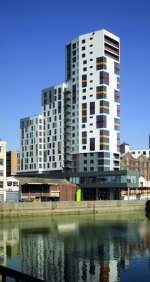New dance centre for Ipswich
Ipswich’s new £8.9 million Jerwood DanceHouse is central to the renaissance of the waterfront


Ipswich may seem a surprising choice for a new £8.9 million dance centre, but Assis Carreiro, artistic director and chief executive of DanceEast, believes it has at least one advantage over London: ‘The artists won't have to battle with the Tube!'
The Jerwood DanceHouse, which officially opened last month, is also affiliated with a dramatic regeneration of Ipswich's waterfront, and a potentially outstanding example of the way in which the Arts can be an intrinsic part of social development.
The striking 23-storey modern structure—which, as the highest building in East Anglia, looms large in Ipswich's skyline—is in direct contrast to the dilapidated mill buildings surrounding it, a deliberate choice by architect John Lyall.
Mr Lyall says: ‘Some locals wanted it to be medieval, but why do something faux-traditional instead of showing innovation? Historically, dancers in this country have been sidelined in terms of rehearsal spaces, stuck in converted warehouses or gloomy basements, but that's changing—now, it's all about designing a functional and beautiful environment for them to work in.'
Created in close consultation with Miss Carreiro, the Jerwood DanceHouse caters to dancers' needs without sacrificing aesthetic value. The 27,000sq ft of facilities include a 66ft by 52ft 200-seater studio theatre, three 52ft by 52ft studios, a Pilates suite, changing facilities, a shop, office space both for DanceEast and for visiting companies, and the whimsically named cafe Danceeats.
To counteract the concrete structure of the building, Mr Lyall has employed sheets of coloured glass rather than tiling, brightly coloured doors and a lovely use of wood throughout, such as in undulating benches in the foyer, which evokes the mill buildings.
The main attraction of the foyer is a sculpture by Stuart Haygarth, champion of found objects—a spiralling multi-coloured piece descending from the ceiling, made up of ballet tutus. This perfectly characterises the fun ethos of the centre, which, with its multimedia installations and bean-bag seating, welcomes visitors instantly.
Sign up for the Country Life Newsletter
Exquisite houses, the beauty of Nature, and how to get the most from your life, straight to your inbox.
The tall dance studios with large windows have a light, airy feeling, as well as practical additions such as cubbyholes in the walls for the rehearsing dancers to store their belongings in. The Red Shoes studio has a moving partition, so it can be split into two spaces, and the main studio theatre has moveable seating, extra fittings set into the walls to give more options for lighting, and a range of vinyl tops for the sprung beech floor, depending on the needs of the company using the space.
These state-of-the-art facilities have attracted an impressive roll call for the opening season, including Sylvie Guillem, the Ballet Boyz, Tamara Rojo, Richard Alston and Russell Maliphant, but Miss Carreiro is adamant that the Jerwood DanceHouse be more than ‘an ivory tower of dance. It's vital to give people ownership of the Arts—you can have a painting hanging on your wall, but a performance is ephemeral.
'Hopefully, this will be a cultural icon for Ipswich to take ownership of, and we're combining great work from the best companies in the world with community projects and facilities, including a partnership with the University of Suffolk, offering the first degree in community dance in the UK.'
Mr Lyall echoes this desire to make dance—and, indeed, the building-accessible to all. He hopes that the Jerwood DanceHouse will be ‘a catalyst for revival', with restaurants, bars, shops and offices surrounding the dance centre and apartments he's created.
He adds: ‘This isn't an isolated structure-it's intrinsic to the life of the community, and a fantastic way to put funding into both artistic endeavours and positive social change.'
Country Life is unlike any other magazine: the only glossy weekly on the newsstand and the only magazine that has been guest-edited by HRH The King not once, but twice. It is a celebration of modern rural life and all its diverse joys and pleasures — that was first published in Queen Victoria's Diamond Jubilee year. Our eclectic mixture of witty and informative content — from the most up-to-date property news and commentary and a coveted glimpse inside some of the UK's best houses and gardens, to gardening, the arts and interior design, written by experts in their field — still cannot be found in print or online, anywhere else.
-
 380 acres and 90 bedrooms on the £25m private island being sold by one of Britain's top music producers
380 acres and 90 bedrooms on the £25m private island being sold by one of Britain's top music producersStormzy, Rihanna and the Rolling Stones are just a part of the story at Osea Island, a dot on the map in the seas off Essex.
By Lotte Brundle
-
 'A delicious chance to step back in time and bask in the best of Britain': An insider's guide to The Season
'A delicious chance to step back in time and bask in the best of Britain': An insider's guide to The SeasonHere's how to navigate this summer's top events in style, from those who know best.
By Madeleine Silver